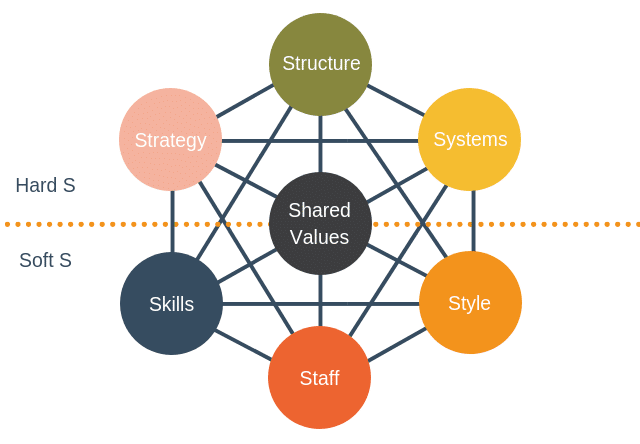The McKinsey’s 7S Model was created by the consulting company McKinsey and Company in the early 1980s and subsequently has become the de facto standard used by practitioners and academics alike in analysing the performance of an organization. The McKinsey’s 7S model is a value based management (VBM) model that describes how one can holistically and effectively organize a company and together, these factors determine the way a company operates. There are seven variables in the model which include structure, strategy, systems, skills, style, staff and shared values. All beginning with ‘s’, justifying why it was termed as the 7S model. These seven variables can be classified as soft components and hard components. Strategy, structure and system were hard components which are usually feasible and easy to identify because they are usually in the policy statements, business plans, organizational charts, organizational structures and systems as recorded in the report.
The 7S model is as shown in figure above, showing the interdependency of the variables. This is illustrated by the model also being termed as the “Managerial Molecule”. The figure shows the integration of each model in a way that all Models have interaction with each other’s and it also shows that Shared Values have common interaction with remaining 6-S models. The description and use of each model is explained bellow and categorised as the Hard S’s and the Soft S’s.
The Hard S’s:
- STRATEGY – Strategy is the set of plans for the action required to restructure the organization for the changes in its external environment. Organizations goals and decision and action of achieving the desired changes are the major factor for the strategy development.
- STRUCTURE – When planning any changes, the organization needs to be organized in a way that that the structure of organization will remain controlled. If the organizational structure is affected due to changes request without controlling the factors like responsibilities, the system can be fully disturbed and it can cause serious problems
- SYSTEMS – In any organization, people are working systematically for performing their tasks and responsibilities. While making changes it is important to take care of the system that the normal routines of staff shall not be affected in a way that they will not be able to perform their jobs.
The Soft S’s:
- SHARED VALUES – Every organization has their personal goals and objectives which gives the reason to all staff and management to move forward to perform their daily tasks. These goals and object have the same values for each and every body in the organization. While making the changes in the organization, the shared values should not be changed otherwise it will take the organization into failure of its goal.
- STYLE – Organization develops and maintains their culture and style of management. Organization’s style also means that the way managers interact with their employee and the way they spend their time. Changing the organization’s culture and style is difficult task as it involves the people personal behaviour
- STAFF – Organization’s success always depends on their staff and teams working on the assigned tasks to achieve their goals. The organization’s now a days are paying more attention into their human resources to have the right and active competences. The need and importance of Human resource management became essential for most of organizations now a day. Changing in staff can really result into a big success or big failure depending on right decisions by HR management.
- SKILLS – Staff without the right skills to perform any tasks can create several problems for the operations and May results into big disasters. Technology is improving our working environment and new skills needed to be developed into existing staff to fulfil their gaps. Skill development through trainings can help the staff to have the right skills to perform their tasks.
The basis of model is, if a business has to excel then the seven elements have to be arranged in a line and equally strengthen. It is used for identifying what requires to be realigned to get better performance, or for uphold alignment & performance throughout erstwhile kind of change. whatsoever the category of change – whether it be restructuring, mergers & acquisitions, new processes & systems or alteration of leadership, this model is used if comprehending how the business rudiments are interconnected, and also it ensures the wider impact of changes done in one region which is engaged into deliberation.
This model is used for study of the present situation, a projected future situation and for identifying fissure and irregularity flanked by them. By making adjustment and fine tuning of the elements of the 7S model can be, the effective organization mechanism can be ensured.
Using the MCKINSEY’S 7S MODEL to Analyze an Organization
The McKinseys 7S model is one that can be applied to almost any organizational or team effectiveness issue. If something within your organization or team is not working, this may mean that there is inconsistency between some of the elements identified by this classic model. Once these inconsistencies are revealed, you can work to align the internal elements to make sure they are all contributing to the shared goals and values.
The process of analyzing where you are right now in terms of these elements is worthwhile in and of itself. But by taking this analysis to the next level and determining the ultimate state for each of the factors, you can really move your organization or team forward.
The model covers almost all parts of business and all major parts of the organization as such it is very important to gather as much information as possible about the organization from all sources available such as press release, organizational news and reports, etc. Primary research such as interviews is more effective.
